






 |

Homepage |

Contents |
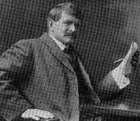 |
The Many Faces of Leacock: His Other Works |
 |
The following description of Leacock's mode of humour represents a synthesis of Gerald Lynch's chapter two, "Between Satire and Sentimentality", in Stephen Leacock: Humour and Humanity (Montreal-Kingston: McGill-Queen's University Press, 1988), Donald Cameron's Faces of Leacock (Toronto: Ryerson, 1967. pp. 102-137), Ralph Curry's Stephen Leacock: Humorist and Humanist (Garden City, N.Y.: Doubleday, 1959), and Robertson Davies's Stephen Leacock . Canadian Writers, no. 7. (Toronto: McClelland and Stewart, 1970).
Humour
Above all, Stephen Leacock wanted his humour to be "kindly". He acquired this view at the age of 18 when he began to learn how to give speeches from a senior teaching instructor, the principal of Strathroy Collegiate Institute. In his biography, The Boy I Left Behind Me (1946), he recreates the event that would become the blueprint for all his humorous works:
I had at that time a certain natural gift of mimicry, could easily hit off people's voices and instinctively reproduce their gestures. So when Jimmy Wetherell [the senior instructor], halfway through a lesson in English, said to me most courteously, "Now will you take the lesson over at that point and continue it?" I did so with a completeness and resemblance to Jimmy's voice and manner which of course delighted the class. Titters ran through the room. Encouraged as an artist, I laid it on too thick. The kindly principal saw it himself and flushed pink. When I finished he said quietly, "I am afraid I admire your brains more than your manners." The words cut me to the quick. I felt them to be so true and yet so completely without malice. For I had no real "nerve," no real "gall." It was the art of imitation that appealed to me. I had not realized how it might affect the person concerned. I learned with it my first lesson in the need for human kindliness as an element in humour. (p. 159)
|
 |
It is in this way that Leacock could never conceive humour with an intent to wound. He spoke of this religiously in his theoretical writings, as he repeats in How to Write, (1943) "Humour, it cannot be too often said, must be kind" (pp. 252-3). Whether writing humour or writing about its technique and theory, he always underscores this premise - humour is at its best when "kindly". Leacock elaborates on this point as he sets out to define sublime humour in Humour and Humanity: An Introduction to the Study of Humour (1937):
The kind of humour that is here described seems to me to reflect the humour of the highest culture, the humour of the future. Its distinction is its kindliness. It does not belong to the literature of effort, of strong convictions and animating purpose. It is rather that of disillusionment, of loss of faith and of the wide charity of mind that has come with the shattering of narrower ideals, not yet replaced. (pp. 205-6)
It is with such hope in humanity that Leacock embarked on a writing career as a humorist. But with such progressive optimism, Leacock realized at the same time he had to avoid sentimentality. His humour never falls under the categories of cold destructive satire or warm and fuzzy sentimentality. He strikes a balance between satire and sentimentality. In a word, Leacock's humour is halfway between a gin on the rocks and a sweet iced tea.
|
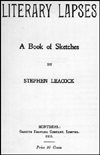 |
Leacock's first published humorous work, Literary Lapses (1910), was a huge success. Many of the sketches depict in a "kindly" fashion the incongruencies between the way things are and the way things ought to be. Of course, Leacock in these sketches is always on the side of man. Ralph Curry, one of Leacock's biographers, observes:
The mark of Stephen Leacock's humor was his sympathy for man. Leacock found much of his fun in the little man beset by advertising, fads, convention, sex, science, cussedness, machinery - social and industrial - and many other impersonal tyrannies (Stephen Leacock, p. 83).
|
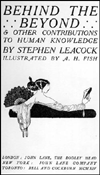
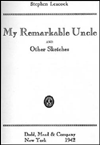 |
It is this sympathy for man that makes Leacock's humour so appealing. He acted as an antenna for early 20th century social anxieties, revealing the absurdities of man's relationship with advancing technology and growing institutions. It is with these insights that Leacock was soon recognized as the world's best known English-speaking humorist between 1915 and 1925. He always appealed to the largest audience; rather than exclusive, he was an inclusive writer. Although his humour was formulaic, which permitted a large readership, he mocked formula in most of his stories by often parodying popular genres.
Leacock's output of humorous works is extraordinary. He produced more than 25 books of humour; some of them include Literary Lapses (1910), Nonsense Novels (1911), Sunshine Sketches of a Little Town (1912), Behind the Beyond, and Other Contributions to Human Knowledge (1913), Arcadian Adventures with the Idle Rich (1914), Moonbeams from the Larger Lunacy (1915), Further Foolishness: Sketches and Satires on the Follies of the Day (1916), Frenzied Fiction (1918), The Hohenzollerns in America: with the Bolsheviks in Berlin, and Other Impossibilities (1919), Winsome Winnie and Other New Nonsense Novels (1920), and Last Leaves (1945).
Leacock influenced other contemporary humorists such as Robert Benchley and S.J. Perelman. His influence, however, is not limited to the medium of the book. In fact, Leacock's shadow can be seen today in contemporary popular culture. In fact, he is representative of a Canadian humour archetype. Leacock's "kindly" humour is in the spirit of the following Canadian artists: Wayne and Schuster, "The Royal Canadian Air Farce", "The Red Green Show", "This Hour has Twenty-Two Minutes", "The Kids in the Hall", "SCTV" (Martin Short, Rick Moranis, Dave Thomas, John Candy, Eugene Levy, Andrea Martin, Catherine O'Hara, Joe Flaherty), Jim Carrey, Dan Ackroyd, Howie Mandel, and Mike Meyers. Some pundits have pointed to Canada's geographical and political juxtaposition with Britain and the United States as the reason for producing great humour. Such a position provides Canadian artists with the advantage of stepping back and seeing the humour of it all.
|
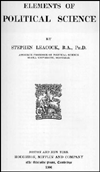
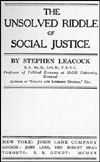
 |
Political Economy
Although Leacock is regarded today as a humorist, his best-selling book during his lifetime, Elements of Political Science (1906), is the vocational face of Leacock, professor of political science. While he never led or created a political "school"of thought, his contribution to the learning of political economy is measured by the sales of his textbook Elements of Political Science that was translated into 19 languages and used in University classrooms around the world for nearly 20 years.
Leacock received his Ph.D. from the University of Chicago in 1903, where he wrote his thesis, "The Doctrine of Laissez-faire", under the supervision of Thorstein Veblen, the famous author of The Theory of the Leisure Class (1899). In fact, Leacock's thought is dramatically influenced by Thorstein Veblen, especially on subjects such as technology and institutions. Another early influence on Leacock was John Stuart Mill who wrote Principles of Political Economy (1848) and On Liberty (1859). Later influences on Leacock's political thought are Frank Taussig, Gustav Cassel, Norman Angell, and John Maynard Keynes. The following is a rough summary of Leacock's political and economic position: he is a tory-humanist; he is opposed to laissez-faire and socialist alternatives in place of capitalist ones; he explains in The Unsolved Riddle of Social Injustice (1920) that his interest lies not so much in production, where he believes freedom is tantamount, but in distribution (supply and demand), where he thinks state intervention is best; production, he argues, is in need of a Gold Standard to establish balance over and against currency depreciation; he envisions a state universal where trade would not be limited by narrow nation state boundaries; such a vision involves a merger between the British Empire and the American Empire. For a detailed look at Leacock as a political scientist, see Myron J. Frankman, "Stephen Leacock, Economist: An Owl Among the Parrots", in Stephen Leacock: A Reappraisal (Ottawa: University of Ottawa Press, 1986. pp. 51-8).
In 1937 Leacock won the Governor General's Award for writing My Discovery of the West: A Discussion of East and West in Canada, a collection of reflections on Canada while he was on his last lecturing tour. Not considered his best work, he won the prestigious award nevertheless, perhaps more on the basis of his past contributions to literature and letters in Canada than for the quality of My Discovery of the West.
|
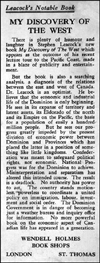
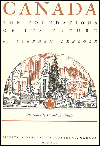
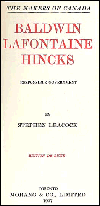 |
History
Leacock wrote six books on the subject of history. Three of the books are contributions to the "Chronicles of Canada" series: Adventurers of the Far North: A Chronicle of the Arctic Seas (1914), The Dawn of Canadian History: A Chronicle of Aboriginal Canada (1914), and The Mariner of St. Malo: A Chronicle of the Voyages of Jacques Cartier (1914). Two other historical books, Canada: The Foundations of Its Future (1941) and Montreal: Seaport and City (1942), offer no new insights into their respective subjects. Baldwin, Lafontaine, Hincks: Responsible Government (1907) is his first historical work and recognized as his best. Leacock was one of the early pioneers of historical writings on Canada and was by no means a specialist, but his contribution to Canadian history should not be overlooked.
Biography
As a humorist, Leacock was influenced by many writers. He greatly admired writers such O. Henry, Mark Twain, Bret Harte, and Charles Dickens and was often writing about them. He even wrote two biographies, one on Mark Twain and the other on Charles Dickens. His Charles Dickens: His Life and Work (1933) is not, by critical standards, a well executed study. At times, there are errors with plot detail as well as misspelled names of characters. On the other hand, his Mark Twain (1932) is a modest achievement that, although brief, adds critically to the study of Twain.
|

Top |
|
|
|